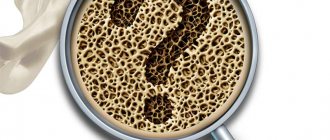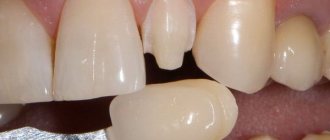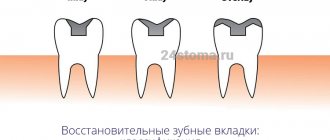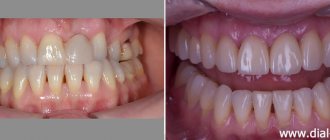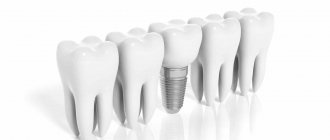People lose teeth for a variety of reasons, and such losses always need to be replaced so as not to disrupt the normal digestion process and the aesthetics of the dentition. When can prosthetics be done after tooth extraction? There is no clear answer to this question, since the clinical situation, the chosen type of prosthetics, and the condition of the tissues after the operation play a role here.
Introduction
Patients very often try to postpone the dental implant procedure. What guides patients and doctors in their decision to place or not place an implant? What happens to bone tissue and gums when a tooth is missing. When can placing an implant help a patient?
Introductory information about the consultant:
The chief physician of the Research Center, Ph.D., answers patient questions. implantologist Dakhkilgov M.U. The word of an expert in the field of implantology is always important. Why is dental implantation an important component of dental health? And when is it absolutely necessary, and when can implantation be postponed?
Magomed Umatgireevich is a surgeon who has personally installed a huge number of implants from almost all leading manufacturers - such as Nobel, Straumann, Astra Tech, Ankylos, Bredent. Doctor to whom patients come from all over the world:
Magomed Dakhkilgov is the chief physician of clinics founded in 2010, which confidently occupy the highest places in professional ratings for implantology in Moscow and Russia.
IMPORTANT! Financial support for dental implantation
Do you want to undergo high-quality dental implantation in our clinics, but have a financial problem? This can be solved! From July 20, 2020
You can also use the dental implantation service in the clinics of the German Implantology Center in installments.
Before we talk about dental implantation itself, let's talk about the factors that precede it. After all, installation of an implant becomes necessary when a person loses a tooth.
Temporary prosthetics
Removable appliances, bridges and other prosthetics can take a month or more to make. But it is necessary to restore a lost front tooth as quickly as possible. For these purposes, provision is made for the installation of temporary prostheses. Their wearing is indicated until the permanent structure is ready and in a number of other cases.
Temporary devices are made of plastic, since there are no strict requirements for them. Plastic products are intended for short-term use, which is justified by the low cost of the material.
What happens to the bone after tooth extraction?
After tooth extraction or loss, bone loss occurs. And if you miss the process of tissue restoration, then a problem will arise and adentia will develop. And the implant will be difficult to place due to the lack of bone volume. The bone structure changes in height, width, and without the presence of bone tissue, an implant cannot be installed. Therefore, delaying implantation is undesirable.
Why does bone loss occur at the site of a missing tooth?
Bone loss occurs because bone tissue does not need to hold “something.” The “something” is a tooth. Therefore, if the jaw or bone does not support the tooth, then the body does not need to waste energy on supporting this tooth.
How long can it take before bone loss begins after tooth extraction? How long does it take for bone tissue to begin resorption? Why do such questions arise: there are often situations when patients who have lost a tooth for one reason or another are in no hurry to install an implant.
Bone resorption occurs differently among patients.
There are several bone biotypes:
- there is a soft bone,
- there is a hard bone,
- There is a medium soft bone.
The size of the bone is the same. If people are strong and powerful, then the loss of bone tissue does not affect much. And if the patient is thin and small, then in this case a loss of bone tissue of 1 millimeter already leads to serious consequences for him.
How bone tissue decreases
hard bone
decreases less quickly. There was a case in practice when a patient, having lost a tooth, came to us at the German Implantology Center 8 years after losing the tooth - and he was given an implant without any problems. But again, you need to take into account which zone is being implanted: the frontal (smile zone) or the chewing section, or the upper jaw, or the lower jaw. Bone loss occurs differently everywhere.
What if soft bone tissue
, then the loss of bone around the extracted tooth occurs very quickly. If, in addition, the patient has concomitant diseases, then bone tissue in most cases will decrease even faster.
Also, the resorption of bone tissue depends on how many teeth have been lost. For example, in the case of the loss of one tooth, the neighboring teeth try to hold the bone in a certain way in the area around the extracted tooth, and in this case it is easier to place an implant:
And if a patient has lost two or three teeth in a row, then the bone tissue settles and decreases much more seriously, both in the absolute value of the decrease and in width and height:
And in this case, the problem of implantation is more serious than in the case of the absence of only one tooth.
General recommendations
During the period of adaptation to dentures, it is recommended to stop eating solid foods and choose softer foods. It is recommended to eat slowly, cutting food into small pieces. You need to chew food on the right and left sides in turn. To restore chewing skills, pear or apple slices are suitable.
It is necessary to completely avoid chewing gum, toffees, toffees and other viscous, sticky products. They can cause disruption of the fixation of the prosthesis, its breakage, and injury to the mucous membrane.
Do not clean dentures with abrasives, alcohol, alkaline or acidic solutions. The use of hard toothbrushes is not recommended. You should not chew candy, nuts, or seeds.
If you have any doubts or need a professional opinion on a problem with your prosthesis, you can contact the Canadian Center for Innovative Technology and Neuromuscular Therapy for a consultation. Our specialists will answer all your questions!
When can an implant be placed, and when should an implant not be placed?
Let's start with problems when implantation was postponed
Let’s not go into the reasons now - either due to the patient’s ignorance, or he is lazy, or there is fear of the operation. It doesn't matter now. The main thing is that there is a time delay in installing the implant. Let's understand where exactly this problem arises if the patient nevertheless decides to postpone implantation.
The very phrase “bone tissue has resolved” does not sound scary and does not frighten a person who does not understand dentistry.
What are the consequences and dangers of bone tissue resorption?
Let’s say we can consider the overall picture: if a patient has no teeth, then he chews food worse, therefore, he has worse digestion, etc. and so on. That is, the patient’s body as a whole suffers more. And if you look in particular, that is, into the oral cavity, then it is easier - it’s just inconvenient to chew food. Although some people manage to chew food without teeth at all. How they manage to do this is difficult to say.
In general, a person adapts to many problems
First he gets used to the absence of one tooth, then two or three, etc. then it loses even more, chewing food becomes not such an important factor. But in vain.
That is, a person is adapting to the created conditions with his teeth, or more precisely, to their absence. And then, when he gets all his teeth back - during the restoration of both the upper and lower jaws, the person becomes... unusual for chewing! They even ask again: “How can I chew it now? I’m used to doing it differently.” It sounds quite anecdotal, but the patient is not laughing at this moment; he has to learn to chew food normally again.
What other factor can attract the attention of the patient, especially women?
, regarding the situation with a missing tooth?
The aesthetics factor of the anterior teeth is very important
If you lose one or two teeth in the chewing department, no one will notice a violation of aesthetics. And if in the anterior region, then yes, the speed of decision-making about installing an implant and further prosthetics is very high, since the patient wants to eliminate a visible dental defect as soon as possible.
Plus, due to the absence of front teeth, there is a retraction of soft tissues, which is visible to the eyes of strangers.
For some reason, patients almost always postpone restoration of the chewing group of teeth through implantation “for later,” although this is wrong
.
It is necessary to restore the chewing area so that it bears the chewing load. If the chewing zone is not restored, then, oddly enough, the frontal, anterior zone of the teeth begins to suffer first.
The front teeth take the load of the chewing teeth and become overloaded: the front teeth begin to bear a load many times greater than what Nature assigned them. As a result of such maximum loads, the ligaments are stretched and the teeth become loose. And at this moment the patient begins to ask himself (and the doctor): “Why are my teeth loose?” And he even diagnoses himself - periodontal disease or periodontitis. But in fact, the patient does not have any periodontal disease or periodontitis; the chewing teeth just need to be restored.
When a patient comes to me at the German Center for aesthetics, then always, if he has a lack of chewing teeth or there is a functional deficiency (that is, crowns that are not restored correctly, chipped crowns, teeth that are destroyed or fillings that are not restored very well), then I always I draw his attention, telling him that first he needs to restore his chewing teeth.
See how this happens in the example of one patient:
And only then – we begin to talk about restoring a smile, about aesthetics:
Because, having made the chewing teeth, we will move the load to its “native” place, normalize the load in the frontal region, and the work that we will then do with the front teeth - veneers, crowns - this work will last happily ever after for many years.
Consent to dental implantation “immediately” and “not immediately”
What happens if the patient:
- immediately agrees to install the implant,
- Will he agree to have an implant installed after some time?
How is the implant installed in these cases? The difference in implant placement in these cases is large
.
Case 1.
If a patient comes and says: “I have a bad toothache and I want to get an implant,” you must first understand why his tooth hurts. If this tooth hurts because it is mobile, and for some reason the mobility affects the gums - that is, the gums actually hurt, this is one case.
Case 2.
But if the tooth hurts, and a large cyst or abscess is identified in the area of the tooth, then this is a different case. Why does an abscess form? It is formed due to the destruction of bone tissue, due to the localization of infection in this destroyed area. And this infection was activated, and a purulent process had already appeared. And this is exactly what hurts. Naturally, in this case, the implant cannot be installed immediately. Because the surrounding tissues are infected, and even if everything is cleaned well and an implant is placed (if there is somewhere to place it, if the bone tissue is not completely destroyed), then there is a high probability of implant rejection. The implant may not take root and may not generate osteogeneration, because the body has not yet stabilized the area of inflammation and has not brought it “in order.” The processes of bone tissue regeneration and the processes of fouling of the implant with bone tissue will not be carried out; the body will simply reject the implant as a foreign body.
Case 3.
If the patient comes, and for some reason he needs to have a tooth removed, and there is an infection (granuloma or small cyst).
Dental implantation if a cyst is detected
People come and say: “I was diagnosed with a cyst. What to do?". The concept of a cyst is very different. First it is a granuloma, then it is a cystogranuloma, and only then it is a cyst. It depends on the size, we won’t go into details now. If this is an inactive phase, that is, if this infection has not yet turned into a purulent infection, then by removing the tooth and removing such a “cyst” or granuloma, and carrying out antiseptic treatment of the place where this focus was located, then in this case you can immediately install an implant . In this situation, it is possible to use a laser. We use a laser to go through and disinfect canals and bone structures.
The only issue that arises is replacing the removed tissue with artificial one. But this all depends on the volume of the defect that formed after removal of the cyst or granuloma.
That is, if the patient has an active phase
inflammation, then an implant
cannot
.
If the inactive phase
, then the tooth implantation after removal
will be successful
.
But there is also a dependence on the location of the granuloma (cyst, cystogranuloma) in relation to the bone tissue. It happens that in the frontal region the anterior bone wall is simply destroyed by this pathogenic structure. And there is virtually no bone tissue. She is not physically there. In this case, you need to perform bone grafting and it takes time for this wall to recover.
Usually, after removal, after inflammation has subsided, it takes at least two months for the body to recover.
When is it not necessary to place an implant?
Such situations 100% include the area of wisdom teeth; removal of “eights” does not require the installation of implants
Stages of the operation
Before removing all the teeth, it is advisable to decide what will happen next, what kind of prosthesis will be installed - a traditional false jaw or a complete replacement of teeth with implants. In fact, this is very important if you choose implantation. Let's look at how a dentist can act, depending on the situation.
On a note! Before any operation, anesthesia is first given, because... removal is a painful process. Modern anesthetics are safe and work well, even if it is a simple “freeze” injection into the jaw. But if the fear is severe, the patient can choose sedation (using xenon gas or intravenous), as well as general anesthesia (general anesthesia).
If, nevertheless, the patient postponed the start of implantation
And he put it off for a very long time. Returns to the doctor after a few years, for example. What regulations will be followed in this case for implant installation? Here, the moment of implantation also depends on the previous tooth extraction. The dentist must remove the tooth in such a way as not to damage the walls
bone tissue. That is, atraumatic:
You should always try to remove the tooth as carefully as possible. And if the tooth was removed with damage to the bone tissue, and the patient was not implanted immediately, then after two months the question of bone tissue augmentation will arise. What to say if the patient arrived even later? Of course, the question of bone restoration and bone grafting will arise.
How disadvantageous is it for a patient to delay dental implantation?
Research conducted in Russia by independent institutes shows that there is no increase in the number of implantations from year to year, despite the fact that the total number of dental services provided to the population is growing steadily every year. The most popular type of implantation is the implantation of the frontal group of teeth, that is, the front teeth. But in the area of the chewing group of teeth, patients are in no hurry to undergo implantation.
Are there medical reasons for postponing dental implants? Medical reasons for refusing to install a dental implant include general reasons:
(diabetes mellitus, hormonal changes, systemic lupus erythematosus, HIV infection, etc.) and
local
.
For local reasons related to the area of the mouth, at present there is practically no list that existed in Russia 15-20-25 years ago, when this area of dentistry had just begun to develop in the country. At that time, the widespread leadership was held by removable dentures, which had and still have a number of serious disadvantages. Yes, there were many local medical reasons, but progress and technology do not stand still. Therefore, now we can (even conditionally) talk about the general reasons for delayed dental implantation, which I mentioned above.
Removable prosthetics as a deterrent to implantation
Removable prosthetics, which prevents the increase in the number of requests for implantation, should probably be considered from the point of view of the economics of patient costs. Removable dentures are much cheaper than implantation followed by turnkey prosthetics. But removable dentures have a significant drawback - they do not prevent the resorption of bone tissue, and in some cases they increase the rate of resorption, with an increase in the pathological load on the temporomandibular joint (TMJ).
Therefore, in the long term, dental implants have a huge advantage
before removable prosthetics to preserve the patient’s bone tissue and, accordingly, the healthy state of all the patient’s maxillofacial system. As they say, “the miser pays,” but not twice, but several times more during his life with removable dentures.
Indications and contraindications for immediate implant placement
Indications
- Mechanical damage to the root - fracture, dislocation
- Restoration of frontal units
- Therapeutic treatment did not bring results
- Sufficient bone volume
- No contraindications
Contraindications
- Deficiency, looseness of bone
- Inflammation at the root apex
- Enlarged socket after removal
- Inflammatory processes of the oral cavity, gum pathologies
- Reduced immunity, systemic diseases
- Pregnancy, breastfeeding period
Let's return to the problem of delayed dental implantation
And let's talk about the situation when a patient decides to have an implant installed 5-10-15 years after its loss. Let’s call it the general term “implantation after some years.”
In implantation, after “some” years, even installing one implant in the chewing area can actually become a big problem.
Implantation in the chewing area
The problem may arise that a traumatic removal of this tooth from the chewing area was previously performed. If a traumatic extraction is performed in the area of the 6th upper or 6th lower tooth or the bone tissue has narrowed, then bone augmentation must be done, because the bone tissue is narrow. There is a problem there, yes. Precisely with bone tissue growth. This problem is quite complex, and for the patient it is an unpleasant procedure. Unpleasant in what way?
The fact is that the patient will be uncomfortable for some time after bone grafting.
The following discomfort is possible after bone grafting:
- there will be swelling,
- chewing will be difficult, you can only eat on the other side of the teeth,
- pain will occur.
Pain after bone grafting depends on the patient’s pain sensitivity threshold. There is really no need to be afraid of pain. There are drugs that reduce this sensitivity and act as a complete pain reliever. The painful moment in implantation and bone grafting is a quickly passing phenomenon, and it is not so tragic.
In November 2021, my colleague, implant surgeon of the Scientific Research Center Kolushev Gleb Valerievich personally performed dental implantation in the chewing department for me, as a patient. Two Astra Tech implants with sinus lift were installed. Below in the video I attach a report on the progress of the operation and my personal feelings:
Dental implantation in the anterior region
Another question is if you need to install an implant in the frontal region, i.e. in the area of the front teeth. In the anterior region, it is more difficult to implant a tooth, because the anterior teeth are an aesthetically significant area:
It will be necessary to do both plastic surgery of the bone material and plastic surgery of the soft tissues, that is, plastic surgery of the mucous membrane. And this is a rather serious point, the doctor must be professionally savvy in this matter, and the process of implantation in combination with plastic surgery turns from a momentary procedure into a complex sequential process that requires quite a lot of time.
Why? Because even 1-2 years are needed to get a good result. What do patients usually need? - so that he comes today
, and
tomorrow
he has already become the most beautiful.
This metamorphosis is not only in the field of implantology, it exists everywhere in the beauty industry. Therefore, the optimal solution must be chosen, and the dental clinic must have advanced equipment and the best technologies that allow solving the most complex problems of the aesthetics of the patient’s smile. Each clinic of the German Implantology Center is equipped with such equipment. And all our specialists undergo continuous training in the best European and world training centers.
In the examples of work presented below, implantation was carried out both in the area of the chewing group of teeth and in the frontal region, followed by prosthetics with two types of crowns. You can select an example to learn more about it.
Price
The Center for Private Dentistry Dr. Levin provides a case payment system.
- When implanting Nobel Biocare PMC Select or Groovy, the cost includes the surgical stages, including the design model, surgery, anesthesia, and all necessary procedures. The price is indicated taking into account the preparatory stage.
- Removal is paid separately, the price includes surgery, inflammation relief, socket rehabilitation, consumables, anesthesia.
- The case for installing a metal-free zirconium dioxide crown includes all stages - impressions, manufacturing, installation.
- Sinus lifting and any bone tissue augmentation operations are paid separately.


